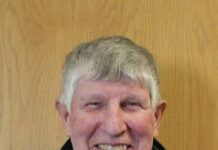The History and Culture of the Spirit Lake Dakota
(The first part of this story ran in the Tuesday, March 11 Devils Lake Journal on page 5. This second part was supposed to run on Tuesday, March 18, but I forgot about it. Please accept my apology that it is a week later than I had planned – Louise Oleson, Editor DLJ)
I interviewed Mr. Archie Redfox Sr. of Tokio, ND, who said he was selected to be the Tiyotipi or Vice President of the Fourth of July in 1909. The celebration was held in Haslem’s Pasture (the Buffalo pasture of today). He said the camp was a mile in diameter, and showed me the location, which was bumpy, uneven grass land, not the level area I expected. The Heyoka had a tipi without a door. They had a rope tied to the top which they used to enter and exit. Some two or three would try to enter the tipi at he top, where the tipi poles crossed. They push and pull at each other in crazy amusing antics. He remembered a Clown dressed as a bee, with wings on his back and a stick as a stinger on his head. He would go about the camp making a buzzing sound. The curious pestering children would follow him, the clown told them to stay away he said he was Wakan (sacred).
Mr. Redfox reported that Turtle Mountain Ojibway Clowns were also present. The Ojibway camped on the north side of the circle of tents. He said his mother made some fried bread and as the Clowns passed by her, she gave them some bread. They carried long crooked bows and crooked sticks for arrows. When they took the bread, each one would lay down on their backs, waved their arms and kicked their legs in the air.
I also interviewed a Canadian Dakota man from Sioux Valley, Manitoba named Frank Hapa who reported that his father Herman Hapa was a Heyoka Itancan, the leader of five or six men. A secret society. His mother named Elizabeth Akisa, made Heyoka songs that had a drum beat similar to the Sun Dance using slow beats at first then changed to double beats. One Heyoka, carried a big funny bow and arrow. Whatever he shot, he took. Others had funny face paint and clothing. His mother became a Christian while Frank was in Boarding School at Pine Falls, Manitoba age 6 years to age 12. While he was in school his mother gave up her Heyoka ways and didn’t bother with her husband’s activities. He told me one time the family got ready to go to a pow-wow, but his father asked to be dropped off about six miles from Sioux Valley and stayed behind as the family departed in their car. Upon arriving at the pow-wow, they discovered their father and the other Heyoka had charged into the dancing circle before they arrived and started dancing crazy. He said he nor his mother knew how the Heyoka arrived before they did, as the Heyoka had to travel many miles trough the country crossing barbed wire fences in the dark of night.
Bibliography
Deloria, Ella Cara The Dakota Way of Life. University of Nebraska Press, Lincoln 2022. Edited by Raymond J. DeMallie and Thierry Veyrie. Pages 23 -26.
Landes, Ruth The Mystic Lake Sioux: Sociology of the Mdewakantonwan Santee. The University of Wisconsin Press. Madison, Milwaukee and London 1968. Pp. 183-185.
Gilmore, Melvin R. Uses of Plants by the Indians of the Upper Missouri River Region. Smithsonian Institution, Bureau of American Ethnology, Annual Report 33. Washington, D.C. 1919. Pages 43-154. See page 103.
Neihardt John G. The Sixth Grandfather: Black Elk’s Teachings given to J.G. Neihardt. University of Nebraska Press 1985.
Wallis W. D. The Canadian Dakota. Anthropological Papers of the American Museum of Natural History. Volume 41 Part one. New York: 1947 Clowns PP111 -225.





